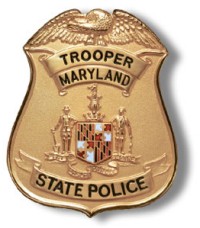
The driver is identified as Gregory M. Jones, 68, of Westminster, Md. He is charged with failure to stop after an accident involving damage to an attended vehicle and failure to return to and remain at the scene of an accident involving damage to an attended vehicle.
Just before 1:30 p.m. on September 23, 2016, troopers from the Westminster Barrack, as well as fire and EMS personnel from the Westminster Fire Engine and Hose Co. 1 and the Reese Volunteer Fire Company were on the scene of a traffic crash on westbound Rt. 140 and Sandymount Road. A marked State Police patrol vehicle blocked the left turn lane and lane one of westbound Rt. 140 to protect the scene. Multiple fire engines and ambulance units were also on the scene. All police and fire vehicles had their emergency lights activated. All personnel were wearing orange safety vests and orange cones had been set up.
While a trooper was inside an ambulance from the Reese VFD interviewing a driver involved in the crash, he was contacted by fire personnel on the scene and informed that a vehicle had just driven through the scene and struck the Westminster ambulance. Investigating further, the trooper found damage to the passenger side of the Westminster ambulance.
Witnesses on the scene told the trooper the driver of a Chrysler 200 convertible had driven around the marked patrol car, into the median, and then back into lane one. As the driver moved through the accident scene, his car struck the side of the Westminster ambulance. The car continued through the scene and then turned onto Sandymount Road. No one on the scene was injured by this vehicle, but a Westminster VFD official reported one of their personnel had to jump out of the way of the car to avoid being hit as it drove through the scene.
A witness obtained a tag number from the vehicle and provided it to State Police. The vehicle was registered to Gregory Jones. The investigating trooper drove from the scene to Jones' residence and found him and the Chrysler 200 there. The car had damage to the passenger side. Further investigation by the trooper resulted in him arresting Jones and transporting him to the Central Booking Center where he was issued the traffic citations.
Motorists are reminded of the danger fire fighters, EMS personnel, police officers and tow service operators face each time they are working at the scene of a traffic crash, traffic stop, or disabled vehicle on or alongside a roadway. Police officers and fire personnel arrange vehicles strategically to safeguard the scene and alert oncoming motorists of their presence. State and county roads personnel are quick to respond to provide additional warning signs, cones and other traffic warning and detour devices to assist motorists.
At a crash scene, police, fire, highway, and tow service personnel work as quickly as possible to rescue those injured, set up detours, conduct the investigation, and remove the damaged vehicles and debris. Regardless of their efforts, traffic delays do occur. Those dedicated to serving others ask that drivers pay attention to traffic reports in order to avoid the scene, follow detours in place and, if delayed at a scene, to be patient and remember those there are working as quickly as they can to reopen the roadway.
Drivers can take advantage of up-to-the minute traffic information by checking www.md511.org or by safely dialing 511 on a cell phone. Drivers can even use "My Maryland 511" to set up traffic alerts specific to their daily routes of travel.
Motorists are also reminded of Maryland's 'move over' law. This law requires drivers to, if possible, move into an open lane away from police cars, fire trucks, ambulances and tow trucks attending to roadside emergencies. If an open lane is not available, drivers must slow to a reasonable and prudent speed that is safe as they pass the scene. The purpose of this law is to provide emergency workers an extra barrier of safety in which to perform their duties.


